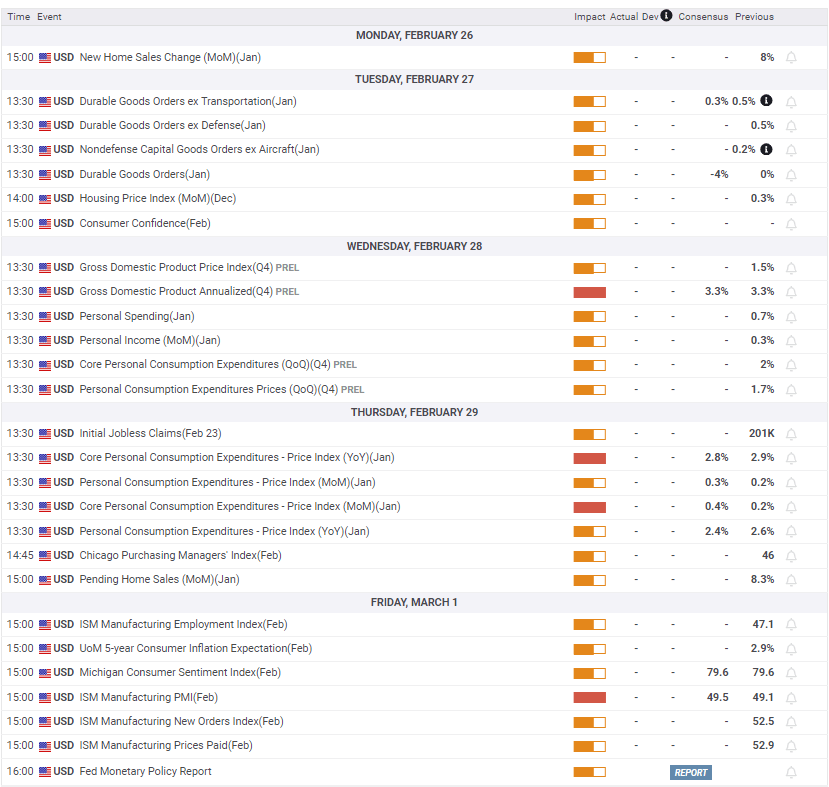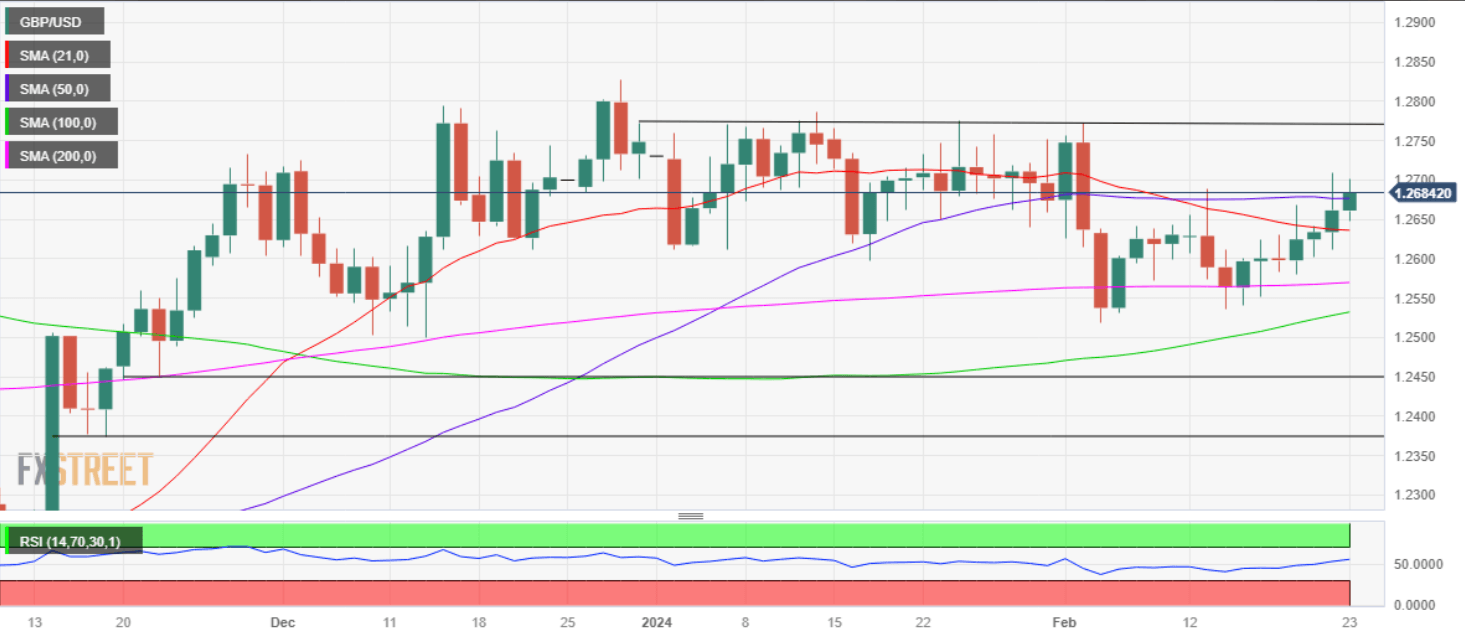GBP/USD Weekly Forecast: Pound Sterling looks for further upside in US data-packed week
- Pound Sterling staged a comeback on the US Dollar pullback.
- US economic data and Fedspeak to dominate GBP/USD price action next week.
- Looking ahead, GBP/USD is set to extend its upswing so long as 200-day SMA holds.

The Pound Sterling (GBP) booked the first weekly gain against the US Dollar (USD), snapping a five-week bearish momentum. GBP/USD staged a comeback from weekly lows to hit a fresh three-week high just above 1.2700.
Pound Sterling benefits from sustained US Dollar weakness
The sentiment around the US Federal Reserve (Fed) interest rate cut expectations drove the GBP/USD price action in the holiday-shortened week. The pair maintained the previous week’s range, trading subdued on Monday, as American traders enjoyed a long weekend on account of the Presidents’ Day holiday.
Thereafter, GBP/USD picked up the recovery momentum, as the US Dollar maintained a submissive tone, despite increased bets for delayed Fed rate cuts amid hawkish FOMC Minutes and commentaries from Fed officials.
Further, mixed US economic data releases combined with the AI optimism-led tech boost and global stock rally kept the downbeat tone intact around the US Dollar. US S&P Global Manufacturing PMI improved to 51.5 from 50.7 in February, while S&P Global Services PMI edged lower to 51.3 from 52.5. Meanwhile, US Initial Jobless Claims fell by 12,000 to 201,000 for the week ending February 17, the Labor Department reported Thursday.
GBP/USD rallied as high as 1.2709 amid a sustained US Dollar retreat. Still, Pound Sterling sellers returned at higher levels as they weighed the dovish comments from Bank of England (BoE) Governor Andrew Bailey, delivered during his testimony before the UK Parliament’s Treasury Select Committee (TSC) in the early part of the week.
Bailey said, "we don't need inflation to be back at the target before cutting rates." "Markets expect rate cuts this year, we do not endorse the market curve, but it is not unreasonable for the market to think that," he added.
The Pound Sterling struggled to hold on to its renewed upswing, as the downside in the US Dollar was cushioned by buoyant US Treasury bond yields. US yields drew support from the Fed policymakers’ continued pushback against early and aggressive Fed rate cuts.
Additionally, mixed S&P Global UK Manufacturing and Services PMI data also sapped the confidence of Pound Sterling buyers, especially after the UK economy entered a technical recession. The seasonally adjusted S&P Global/CIPS UK Manufacturing PMI improved slightly from 47.0 in January to 47.1 in February, below the market consensus of 47.5. Meanwhile, the Preliminary UK Services Business Activity Index stayed unchanged at 54.3 in February, beating the consensus forecast of 54.1.
Week ahead: Top-tier US data in focus
Following a holiday-shortened and relatively data-light week, GBP/USD traders look forward to a host of top-tier US economic data releases, as the UK calendar remains a quiet one.
Monday will see a couple of BoE policymakers speaking, followed by the US New Home Sales data. BoE officials Sarah Breeden and Huw Pill will take up the rostrum. On Tuesday, the US Durable Goods Orders and Conference Board Consumer Confidence data will keep traders entertained. BoE policymaker Dave Ramsden will also make an appearance that day.
The US docket will feature the second estimate of the fourth-quarter Gross Domestic Product (GDP) on Wednesday alongside the release of the Personal Spending and Personal Income data.
The US weekly Jobless Claims will be reported on Thursday but the key focus will be on the Core Personal Consumption Expenditures (PCE) - Price Index, the Fed’s preferred inflation gauge.
Friday will be a busy day, with the final prints of the S&P Global UK and US Manufacturing PMI on the cards. However, the main event risk will be the ISM Manufacturing PMI.
Markets will continue to closely scrutinize the speeches from the Fed policymakers for gauging the timing of the first-rate cut this year.
GBP/USD: Technical Outlook
The short-term outlook for GBP/USD suggests that the recovery momentum is likely to gather traction on a sustained break above the 50-day Simple Moving Average (SMA) at 1.2678.
The 14-day Relative Strength Index (RSI) is sitting just above the 50 level, suggesting that there is more room for upside in the pair.
If the Pound Sterling buyers manage to close the week above the 50-day SMA at 1.2678, a fresh uptrend could be initiated toward the 1.2750 psychological barrier.
The next topside barrier for the pair is seen at the static resistance near 1.2775. The December 28 high of 1.2828 will be next on the buyers’ radars.
On a failure to close the week above the 50-day SMA of 1.2678, Pound Sterling could see a temporary pullback toward the 200-day SMA at 1.2570.
However, the 21-day SMA at 1.2630 could offer some support to Pound Sterling buyers prior.
A convincing break below the 200-day SMA at 1.2570 will put the 100-day SMA at 1.2532 in sight. Further south, the 1.2450 psychological level could test bullish commitments.
Pound Sterling FAQs
What is the Pound Sterling?
The Pound Sterling (GBP) is the oldest currency in the world (886 AD) and the official currency of the United Kingdom. It is the fourth most traded unit for foreign exchange (FX) in the world, accounting for 12% of all transactions, averaging $630 billion a day, according to 2022 data.
Its key trading pairs are GBP/USD, aka ‘Cable’, which accounts for 11% of FX, GBP/JPY, or the ‘Dragon’ as it is known by traders (3%), and EUR/GBP (2%). The Pound Sterling is issued by the Bank of England (BoE).
How do the decisions of the Bank of England impact on the Pound Sterling?
The single most important factor influencing the value of the Pound Sterling is monetary policy decided by the Bank of England. The BoE bases its decisions on whether it has achieved its primary goal of “price stability” – a steady inflation rate of around 2%. Its primary tool for achieving this is the adjustment of interest rates.
When inflation is too high, the BoE will try to rein it in by raising interest rates, making it more expensive for people and businesses to access credit. This is generally positive for GBP, as higher interest rates make the UK a more attractive place for global investors to park their money.
When inflation falls too low it is a sign economic growth is slowing. In this scenario, the BoE will consider lowering interest rates to cheapen credit so businesses will borrow more to invest in growth-generating projects.
How does economic data influence the value of the Pound?
Data releases gauge the health of the economy and can impact the value of the Pound Sterling. Indicators such as GDP, Manufacturing and Services PMIs, and employment can all influence the direction of the GBP.
A strong economy is good for Sterling. Not only does it attract more foreign investment but it may encourage the BoE to put up interest rates, which will directly strengthen GBP. Otherwise, if economic data is weak, the Pound Sterling is likely to fall.
How does the Trade Balance impact the Pound?
Another significant data release for the Pound Sterling is the Trade Balance. This indicator measures the difference between what a country earns from its exports and what it spends on imports over a given period.
If a country produces highly sought-after exports, its currency will benefit purely from the extra demand created from foreign buyers seeking to purchase these goods. Therefore, a positive net Trade Balance strengthens a currency and vice versa for a negative balance.
Premium
You have reached your limit of 3 free articles for this month.
Start your subscription and get access to all our original articles.
Author

Dhwani Mehta
FXStreet
Residing in Mumbai (India), Dhwani is a Senior Analyst and Manager of the Asian session at FXStreet. She has over 10 years of experience in analyzing and covering the global financial markets, with specialization in Forex and commodities markets.



















